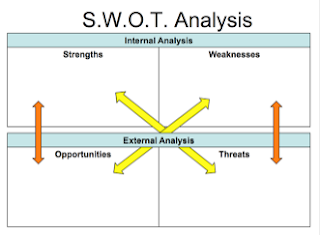Why, might you ask? In order to know where a company wants to go in the future we need to understand where we are right now. Usually, companies focus on what they want to do, not what they may be best at, or what others are better at.
An effective tool for understanding where the company stands, and where it might want to go, is a SWOT analysis:
SWOT Analysis is a structured planning method used to evaluate the Strengths, Weaknesses, Opportunities, and Threats involved in a project or in a business venture. A SWOT analysis can be carried out for a product, place, industry or person. (Wikipedia).
When I was first introduced to SWOT, I asked myself "What benefit could my company receive - this is silly." Over time and with a little practice, valuable information can be gained. Some feel SWOT is business school 101 stuff, but if thoughtfully done, SWOT brings insightful analysis.
The strongest benefit is that, done correctly, good business decisions (both strategic and tactical) can be achieved. These decisions and directions will be derived from a realistic view of your company's position in the marketplace.
First, the process:
- Sit with a group of people, this can include customers, it is important to include many internal stakeholders (not just management people). Bring unbiased people to this discussion - you need a hard analytical look, not Pollyanna types.
- Decide on SWOT topic (ex: your company, your competition, the key objective).
- We use a white board divided into four quadrants.
- Note the top half is about internal issues (strengths and weaknesses) and the bottom half is about external issues (opportunity and threats).
- Be free form about putting things in each quadrant, just make sure the statement is really a strength, weakness, opportunity, or threat. Specific is better than general. Question if the statement is real, or what we wish it to be.
- Strength - great people (way too general).
- Weakness - not enough projects (that is more of a threat than a weakness).
- Opportunity - there is a bond issue to create new infrastructure (great example)
- Threat - competition (this can be a threat, it can also be an opportunity) - see below.
Strengths can lead to opportunities, while weaknesses create threats (orange arrows).
Strengths reduce threats, while weaknesses, when corrected, can create new opportunities (yellow arrows).
Looking at the problem in a new way, brings new connections, new data to review, and maybe a new look at a familiar set of issues.
I have done SWOT analysis numerous times, and have found that it has been a valuable exercise, with new insights, new connections, and also the stakeholders are both engaged and educated.
 David Haynes, NCARB, PMP, LEED AP
David Haynes, NCARB, PMP, LEED APIdeate Director of Consulting
David is a Registered Architect, Project Management Certified Professional, who previously had his own architectural practice and was President of a commercial design-build construction company for 15 years. A graduate of University of Arizona, he has worked as an Architect, contractor, developer and as a national construction manager for a national retailer. David currently provides business process analysis, virtualization and change management solutions for AEC clients across the United States involved in the design and building industry. Follow David on Twitter: @dhaynestech
Get it. Know it. Use it.



